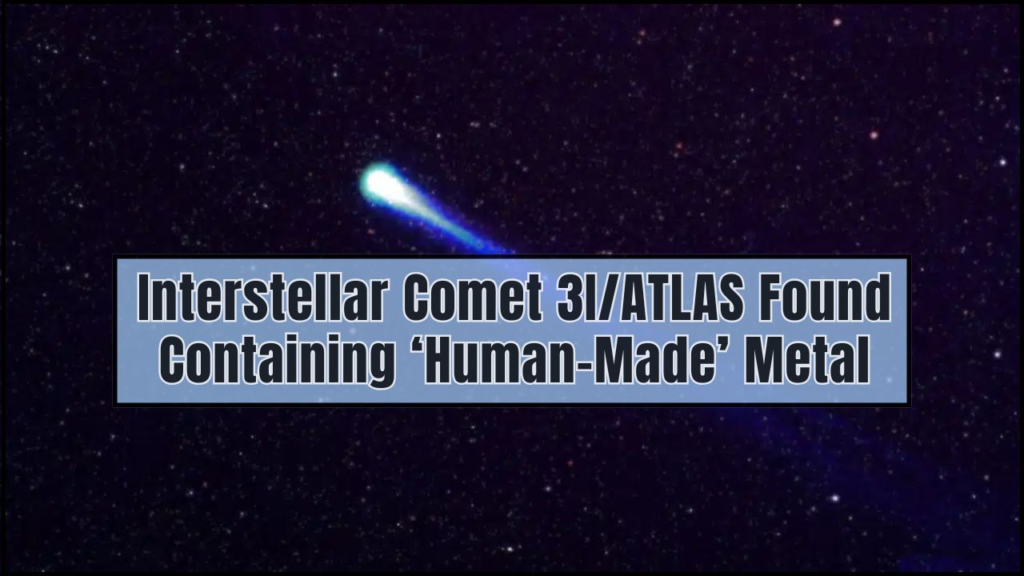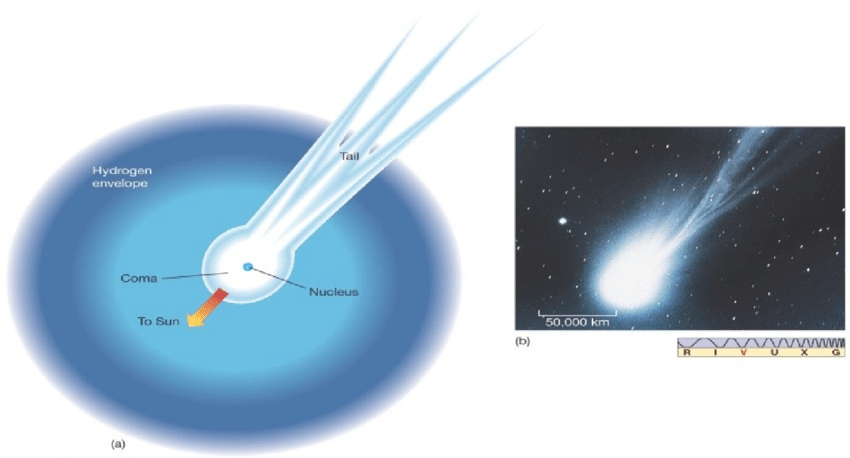An international team of astronomers has detected an unprecedented chemical signature from interstellar comet 3I/ATLAS, raising new questions about the composition of objects entering the solar system from beyond. The detection of unusually high nickel emissions has led to public speculation about possible artificial origins, though most scientists emphasize natural explanations remain far more likely.

The findings, revealed through early spectral analyses by observatories in the United States and Europe, have already attracted widespread attention from both the scientific community and the public. The debate echoes similar controversies surrounding the 2017 discovery of ‘Oumuamua, the first known interstellar visitor.
Interstellar Comet 3I/ATLAS
| Key Detail | Information |
|---|---|
| Official designation | 3I/ATLAS (C/2025 N1) |
| Discovery date | July 1, 2025 |
| Chemical anomaly | High Ni/Fe ratio; possible nickel tetracarbonyl |
| Orbital nature | Hyperbolic trajectory (interstellar origin) |
| Notable commentator | Avi Loeb, Harvard University |
| Current phase | Pre-perihelion; inbound toward inner solar system |
| Next observation campaign | November–December 2025 |
A Unique Metal Signature in Space
Initial observations of 3I/ATLAS using high-resolution spectroscopy have revealed a nickel-to-iron ratio far exceeding that of typical solar system comets, according to a preprint published in September on arXiv. The nickel emissions appear strong and sustained, while iron lines emerge only at closer solar distances.
Researchers have suggested that the signature could be caused by the sublimation of nickel tetracarbonyl (Ni(CO)₄) — a volatile metal-carbon compound that forms when nickel reacts with carbon monoxide. While this compound is commonly encountered in metallurgical industries on Earth, its natural formation in space has never been documented at this scale.
“This is a remarkable finding,” said Dr. Maria Jensen, a planetary scientist with the European Space Agency (ESA). “We’re seeing a metal signature unlike anything observed in comets before. That doesn’t necessarily mean it’s artificial — it means we have something new to learn about interstellar chemistry.”
Loeb’s Controversial Interpretation
Among those commenting on the discovery is Avi Loeb, a Harvard astrophysicist known for proposing unconventional explanations for cosmic phenomena. In interviews and public statements, Loeb argued that the chemical fingerprint of 3I/ATLAS resembles industrial processes, implying the object could be artificial in origin.
“We find nickel tetracarbonyl in refineries and metallurgical facilities, not in nature,” Loeb told The Economic Times. “The absence of similar signals in solar system comets is telling.”
His comments have reignited public fascination with the idea of extraterrestrial technology, much as his earlier claims did regarding ‘Oumuamua. Loeb’s interpretation, however, remains a minority view within the scientific community.
NASA and Others Urge Scientific Caution
NASA and other agencies have cautioned against premature conclusions. “There are natural chemical pathways that could explain this,” said Dr. Jennifer Raymond, chief scientist at NASA’s Astrobiology Program. “Interstellar objects may have formed under conditions unlike anything in our solar system. That doesn’t make them artificial.”
Many researchers stress that nickel carbonyl compounds can form naturally in environments with abundant carbon monoxide, high nickel content, and low oxygen levels — conditions that may exist around young stars or in certain icy bodies formed in distant planetary systems.
“This is exactly why interstellar objects are so scientifically valuable,” said Dr. Trevor Haines of the University of Cambridge. “They provide samples of environments we can’t observe directly. It’s like receiving geological postcards from another star system.”
The Chemistry: Why Nickel Tetracarbonyl Matters

Nickel tetracarbonyl (Ni(CO)₄) is a colorless, volatile, and highly toxic gas. On Earth, it is used in the Mond process to refine nickel. Because it forms under specific temperature and pressure conditions, its detection in space has raised eyebrows.
However, recent astrochemical modeling suggests that metal carbonyl compounds could form inside protoplanetary disks where temperatures are moderate and CO gas is abundant. If 3I/ATLAS originated in such an environment, these compounds may have been trapped in its icy nucleus for billions of years before being released during its current solar encounter.
“This may be the first time we’re seeing a naturally occurring metal carbonyl outside Earth,” said Dr. Kenta Aramaki, an astrochemist at the University of Tokyo. “It would be revolutionary for our understanding of chemical diversity in the galaxy.”
Historical Context: A Rare Visitor
3I/ATLAS is only the third confirmed interstellar object to pass through the solar system. The first, 1I/‘Oumuamua, was detected in 2017 and famously exhibited unusual acceleration and shape. The second, 2I/Borisov, discovered in 2019, behaved more like a typical comet but with a distinctive chemical signature.
Unlike ‘Oumuamua, 3I/ATLAS has a well-developed coma and tail, which allows astronomers to study its composition in much greater detail. Its hyperbolic trajectory confirms that it is not bound to the Sun and will continue its journey back into interstellar space after passing perihelion in late 2025.
“Each of these objects gives us a different piece of the puzzle,” said Dr. Nicole Francois of the Paris Observatory. “ATLAS may reveal something we’ve never encountered before.”
How Scientists Study Comet Chemistry

The detection of nickel and iron in 3I/ATLAS came through spectroscopic analysis. As sunlight interacts with the comet’s coma — a cloud of gas and dust surrounding its nucleus — different elements emit or absorb light at characteristic wavelengths.
Telescopes on Earth and in space can read these spectral fingerprints. In this case, unusually strong nickel lines were identified by both the Very Large Telescope (VLT) in Chile and NASA’s Infrared Telescope Facility in Hawaii. Follow-up observations with the James Webb Space Telescope (JWST) are planned.
Spectroscopy is a key tool for determining the composition of objects we cannot sample directly. It has been used to identify water, organic molecules, and various metals in comets for decades. But the Ni(CO)₄ signature, if confirmed, would be unprecedented.
What This Could Mean for Astrobiology
The detection of complex metal compounds in an interstellar object has implications beyond cometary science. It touches on astrobiology, planetary formation, and the search for extraterrestrial life.
“If this compound formed naturally, it tells us that the chemistry in other planetary systems is more varied than we thought,” said Dr. Sarah Adeyemi, a researcher at the SETI Institute. “If it didn’t, then we may have a truly extraordinary find. Either way, we win scientifically.”
NASA has made clear that there is no evidence of technological artifacts associated with 3I/ATLAS. But the agency acknowledges that studying its composition could help refine the search for “technosignatures” — measurable indicators of advanced civilizations.
International Research Response
The discovery has triggered rapid coordination among international space agencies, observatories, and research institutions. Teams from NASA, ESA, the European Southern Observatory, and the National Astronomical Observatory of Japan have scheduled observation campaigns as the comet approaches perihelion.
“We have a narrow observational window,” said Dr. Raymond. “Once it passes by, it will not return. We must collect as much data as possible.”
A special session has been added to the upcoming American Astronomical Society (AAS) winter meeting to discuss the early findings. Peer-reviewed papers are expected to follow in late 2025 and early 2026.
Public Interest and Media Speculation
As with ‘Oumuamua, public reaction has been swift — and sometimes sensational. Headlines framing the nickel signature as “human-made metal” have circulated widely, fueled by social media posts and speculative commentary.
NASA has attempted to temper expectations. “Extraordinary claims require extraordinary evidence,” the agency said in a public statement. “Scientific analysis is ongoing, and premature conclusions may be misleading.”
Public fascination with extraterrestrial technology has grown in recent years, partly due to renewed interest from governments and defense agencies in unidentified aerial phenomena (UAP) and space surveillance. Some experts say the ATLAS case illustrates the need for better science communication.
“When the data is unusual, speculation fills the vacuum,” said Dr. Haines. “We need to communicate what we know — and what we don’t — clearly.”
Economic and Policy Implications
Although the comet poses no threat to Earth, its study is influencing funding and strategic priorities in planetary defense and space science. The U.S. National Science Foundation and the European Space Agency have both announced temporary reallocation of telescope time to support 3I/ATLAS observations.
Some policymakers see the event as justification for investing in rapid-response missions capable of intercepting interstellar objects. A concept study for such a mission — sometimes referred to as “Interstellar Probe” — has been under review at NASA’s Jet Propulsion Laboratory.
“Objects like ATLAS won’t wait for us,” said Dr. Susan Miller, a policy analyst at the Center for Space Governance. “We either build the capability to study them up close, or we miss once-in-a-lifetime opportunities.”
Looking Ahead
3I/ATLAS will reach its closest point to the Sun in late December 2025 before departing the solar system forever. Over the coming months, astronomers hope to confirm whether the nickel signature truly represents nickel tetracarbonyl or another form of nickel compound.
“This is the scientific process at work,” said Dr. Raymond. “We have intriguing data, competing hypotheses, and the means to test them.”
Whatever the outcome, scientists agree that the object’s passage represents a rare and valuable opportunity to study matter formed in another star system. It may reshape understanding of how planets and comets form across the galaxy.

















